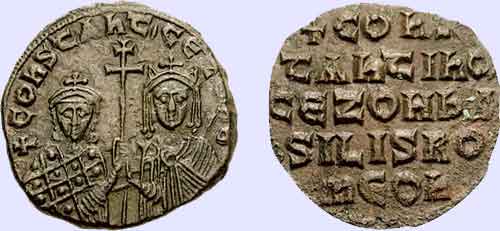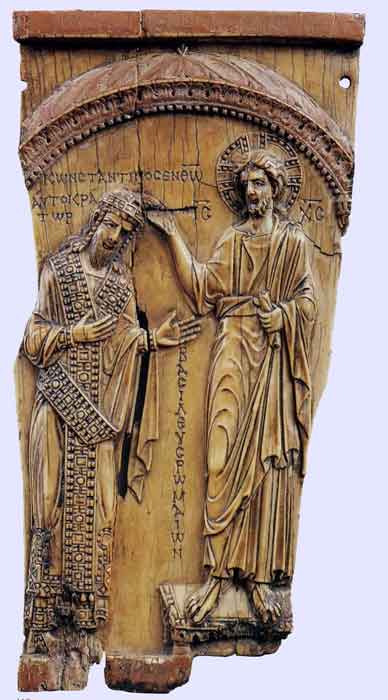.

Constantine and his mother Zoë. Image: http://www.cngcoins.com
Constantine VII Porphyrogennetos or Porphyrogenitus, "the Purple-born" (Greek: Κωνσταντίνος Ζ΄ Πορφυρογέννητος, Kōnstantinos VII Porphyrogennētos), (Constantinople, 905 – November 9, 959 in Constantinople) was the son of the Byzantine emperor Leo VI and his fourth wife Zoe Karvounopsina. He was also the nephew of the Emperor Alexander. He is famous for his two descriptive books, De Administrando Imperio and De Ceremoniis.
His nickname alludes to the Purple Room of the imperial palace, where legitimate children of reigning emperors were normally born. Constantine was also born in this room, although his mother Zoe had not been married to Leo at that time. Nevertheless, the epithet allowed him to underline his position as the legitimized son, as opposed to all others who claimed the throne during his lifetime.
Reign
Constantine was an illegitimate son born before an uncanonical fourth marriage. To help legitimize him, he had been born in the Purple Room of the imperial palace, and he had been associated on the throne by his father and uncle on May 15, 908. After the death of his uncle Alexander in 913, he succeeded to the throne at the age of seven, under the regency of the Patriarch Nicholas Mystikos. His regent was presently forced to make peace with Tsar Simeon of Bulgaria, whom he reluctantly recognized as Bulgarian emperor. Because of this unpopular concession, Nicholas was driven out of the regency by Constantine's mother Zoe.

Christ Crowning Constantine VII (945).
Zoe was no more successful with the Bulgarians, by whom her main supporter, the general Leo Phokas, was defeated in 917, and in 919 she was replaced by the admiral Romanos Lekapenos, who married his daughter Helena to Constantine. Romanos used his position to advance to the ranks of basileopatōr in May 919, kaisar (Caesar) in September 920, and finally co-emperor in December of the same year. Thus, just short of reaching nominal majority, Constantine was again eclipsed by a senior emperor.
Constantine's youth had been a sad one for his unpleasant appearance, his taciturn nature and his relegation at the third level of succession behind the eldest son of Romanos I Lekapenos. Nevertheless, he was a very intelligent young man with a large range of interests, and dedicated those years to study the court's ceremonial.
Romanos kept power for himself and maintained it until 944, when he was deposed by his sons Stephen and Constantine. With the help of his wife, Constantine VII succeeded in removing his brothers-in-law and on January 27, 945, Constantine VII was once again sole emperor at the age of 39, after a life spent in the shadow. Several months later, Constantine VII crowned his own son Romanos II co-emperor. Having never exercised executive authority, Constantine remained primarily devoted to his scholarly pursuits and relegated his authority to bureaucrats and generals, as well as his energetic wife Helena Lekapene.
In 949 Constantine launched a new attack against the Arab corsairs hiding in Crete, but like his father's attempt to retake the island in 911, this attempt also failed. On the Eastern frontier things went better, even if with alternate success: in 949 the Byzantines conquered Germanicea, repeatedly defeated the enemy armies and in 952 crossed the upper Euphrates. But in 953 the Arab amir Saif ad-Dawla retook Germanicea and entered the imperial territory. The land in the east was eventually recovered by Nikephoros Phokas, who conquered Hadath, in northern Syria, in 958, and by the Armenian general John Tzimiskes, who one year later captured Samosata, in northern Mesopotamia. An Arab fleet was also destroyed by Greek fire in 957. Constantine's efforts to retake themes lost to the Arabs were the first such efforts to have any real success.
Constantine had intense diplomatic relationships with foreign courts, including the caliph of Cordoba Abd ar-Rahman III and Otto I, King of Germany. In the autumn of 957 Constantine was visited by Olga, princess of the Kievan Rus'. The reasons for this voyage have never been clarified: in any case, she was baptised with the name Helena, and began to convert her people to Christianity.
Constantine VII died in November 959 and was succeeded by his son Romanos II. It was rumored that Constantine had been poisoned by his son or his daughter-in-law Theophano.
Literary activity
Although he was a satisfactory emperor, Constantine is more renowned for his abilities as a writer and scholar. He wrote, or had others write in his name, the works De cerimoniis aulae byzantinae ("On Ceremonies"), describing the kinds of court ceremonies also described later in a more negative light by Liutprand of Cremona; De Administrando Imperio ("On the Administration of the Empire"), giving advice on running the empire internally and also how to fight external enemies; and a history of the Empire covering events following the death of the chronographer Theophanes the Confessor in 817. Though these books are not as insightful as Constantine believed them to be, they nevertheless are a most useful source of information about nations neighbouring with Byzantium, and a good insight into the Emperor himself. Constantine was a great collector of books, manuscripts and art works in general, and was indeed a good painter.
Family
By his wife Helena Lekapene, the daughter of Emperor Romanos I, Constantine VII had several children, including:
- Leo, who died young.
- Romanos II
- Theodora, who married Emperor John I Tzimiskes.
References
- Runciman, Steven. The Emperor Romanus Lecapenus and his Reign. Cambridge: University Press, 1990. (Originally published 1929.) ISBN 0-521-35722-5
- Toynbee, Arnold. Constantine Porphyrogenitus and his world. Oxford, 1973. ISBN 0-19-215253-X. 768pp.
Preceded by: Alexander III
Byzantine Emperor 913–920
Succeeded by: Romanus I
Preceded by: Romanus I
Byzantine Emperor 945–959
Succeeded by: Romanus II
| Ancient Greece
Science, Technology , Medicine , Warfare, , Biographies , Life , Cities/Places/Maps , Arts , Literature , Philosophy ,Olympics, Mythology , History , Images Medieval Greece / Byzantine Empire Science, Technology, Arts, , Warfare , Literature, Biographies, Icons, History Modern Greece Cities, Islands, Regions, Fauna/Flora ,Biographies , History , Warfare, Science/Technology, Literature, Music , Arts , Film/Actors , Sport , Fashion --- |
Retrieved from "http://en.wikipedia.org"
All text is available under the terms of the GNU Free Documentation License

